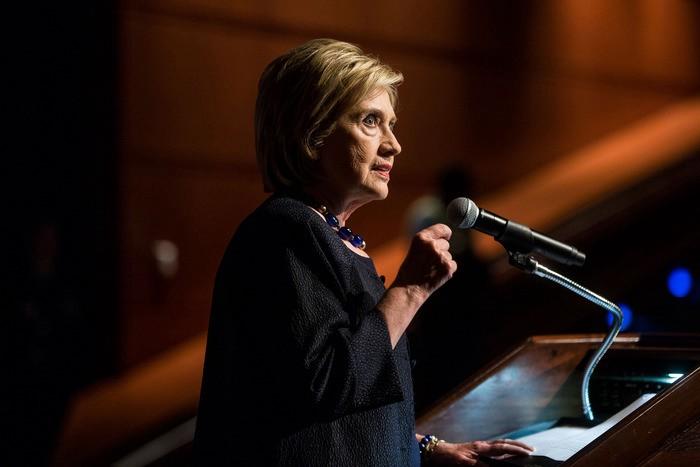Zombie Nation? The Democratic Party Is Dead, And Everyone Knows It But Them.
Helen Buyniski, HelenOfDestroy.com. Oct. 22, 2019.
Failed presidential candidate Hillary Clinton, thought to have finally retired from politics after an embarrassing electoral loss to a politically-inexperienced reality show personality, is
threatening to enter the 2020 race, serving up reheated Cold War fearmongering and an ironclad sense of royal privilege to a Trump-weary populace. A morally and fiscally bankrupt Democratic Party is poised to enable this sick drama with the help of a spineless and compliant media.

How could this possibly happen? Surely Democrats learned their lesson after their decision to take Clinton’s money in order to stay financially solvent in 2016 required them to rig the primaries in her favor, a crime that likely tanked her candidacy when it was revealed by WikiLeaks? Surely the mainstream media realizes that, three years on, the preposterous Russiagate conspiracy theory they cooked up to defend her has ripped the last shreds of journalistic integrity out of the mainstream media establishment?
Just kidding — the Democratic Party and its media handmaidens bargained away their morals long ago. They’re aiding and abetting a Clinton comeback, wheeling her out to give her opinion on everything from the latest steps toward peace in Syria (
bad, needs more war) to the 2020 candidates. Last week, she took aim at Tulsi Gabbard, the best hope the party has of getting voters excited enough to show up in 2020,
claiming (without a shred of evidence) that the National Guard major and former DNC chair is being groomed by Russia to act as a third-party spoiler, handing the election to Trump. Had such a claim come from anyone else, the DNC would have slapped it down. But they know on which side their bread is buttered. They’d rather lose than defy their queen.
Let’s do the time warp again
This month’s primary debates proved that, if nothing else, the party has refused to move on from 2016. Candidates clamored to distinguish themselves as the biggest Trump-hater and impeachment zealot, with not one appearing to comprehend that next in line behind their favorite punching bag is Mike Pence. The vice president is a man so possessed by religious sexual phobia that he refuses to be alone in a room with a woman. A Christian Zionist, he is even more willing than Trump to send US soldiers to fight Israel’s battles — the better to hasten the Rapture. Only Andrew Yang — a party outsider — dared speak the truth: “When we are talking about Donald Trump, we’re losing.”
Indeed, everything about the 2020 election is signaling a repeat of the last one. The DNC is
broke again, ripe for a Clinton rescue that will once again require the rigging of the primary in return for her kindness. Naysayers who once laughed at the idea of yet another Clinton candidacy are reconsidering their scorn, and former Trump strategist Steve Bannon
insists she is, in fact, running — merely waiting for the right moment to officially declare her candidacy. Certainly the media blitz of the past few weeks — ostensibly to promote a book co-written with her do-nothing daughter, but in reality a string of opportunities for her to denounce the “illegitimate” president and remind America that the position is rightfully hers — looks like a campaign publicity tour.
For all that Clinton says she empathizes with current Democratic frontrunner Joe Biden, currently being accused of corruption, she has, in these interviews, always brought the conversation back around to 2016, insisting that “the most outrageously false things” were said about her as well (and lamenting that “enough people believed them” to rob her of the presidency). Biden, like Clinton, is still being pushed as the 2020 favorite, despite coming with decades of baggage including flagrant corruption (threatening to withhold $1 billion in IMF loans from Ukraine until it fired the prosecutor probing an energy company that gave his son a no-show job is only the tip of the iceberg).
Even the New York Times has pointed out the
similarities between their two candidacies — both physically deteriorating before voters’ eyes, uninterested in changing the status quo, and embraced by the wealthy donors that keep the party afloat. Biden’s Ukraine problem is as massive and impossible to avoid as Clinton’s email problem. Biden, like Clinton, is positioning himself as not the best candidate, but the only one who can beat Trump — embracing his identity as, he hopes, the lesser of two evils. Both have a long history in politics, dozens of skeletons in the closet (literally, in Clinton’s case), and a string of failed presidential attempts. Both cringingly pander to working-class and minority voters despite a history of racism (“superpredators,” the 1994 crime bill, close friendship with segregationists) and classism (NAFTA).
If at first you don’t succeed…
Ever the strategist, Clinton is likely biding her time until the facts come out about Biden’s involvement in Ukrainian natural gas company Burisma during impeachment hearings and sink his candidacy.She’ll then swoop in, volunteering to take his place as the crusty old standard-bearer of the Democratic pack. Biden’s suicidal stubbornness all but ensures he’ll go down in flames (despite his son Hunter’s admitted drug problems and the obvious nepotism and corruption behind his receiving a $60,000/month directorship just months after being kicked out of the Navy Reserves for cocaine use, Biden
insists Hunter will join him on the campaign trail).
Clinton feels the presidency is hers by divine right — that it’s “her turn” to take the reins, like she was promised after Obama snatched it out from under her in 2008. Having paid her dues as First Lady, the long-suffering wife and enabler of serial rapist Bill Clinton occupied a Senate seat just long enough to present herself to the public as a stateswoman in her own right, then made a run at the glass ceiling of the presidency — only to be rejected in favor of a spray-tanned novice without her baggage. Patiently serving as Secretary of State, she oversaw the destruction of Libya, once the jewel of the Middle East under Gaddafi with the highest standard of living on the African continent, turning it into the failed state with open-air slave markets it is today. Thwarted in her efforts to do the same in Syria, she left the White House in 2012.

Clinton
transformed the State Department into an extension of the Pentagon via her misleadingly-named “smart power” philosophy. The agency once tasked with solving America’s foreign policy problems diplomatically now merely provides diplomatic cover for regime-change operations like the one she helped engineer in Ukraine in 2014 (while she left the State Department in 2013, the processes she set in motion would culminate in the Maidan revolution that saw actual Nazis take over in Kiev) and the one currently trying to pry Hong Kong from China’s grasp.
She also monetized the position, selling access to the presidency through the Clinton Foundation. The Clintons vastly enriched themselves at the expense of the rest of the world, having never met a dictator they didn’t like. But while they elevated corruption to an art form, their actions were wholly in keeping with the modus operandi of the Democratic Party. Swaddle oneself in the appearance of helping the less fortunate (Clinton has appeared with countless ‘save the children’ and ‘women’s empowerment’ type groups like Somaly Mam’s AFESIP, which notoriously
invented Cambodian child brothel horror stories out of whole cloth) while exploiting them to within an inch of their lives (Haitians still protest outside Clinton events over the Foundation’s
decision to give over 90 percent of the $13.3 billion given in response to the 2010 earthquake to foreign contractors and Foundation donors while Haitians starved and died).
The rot goes to the core
Clinton wouldn’t be able to get away with this sort of thing if her party wasn’t fully on board with such moral depravity. The current impeachment circus is merely the latest proof that they do not believe anything they say in public. For the entire party and its stenographers in the media to turn on a dime from accusing Trump of colluding with Russia to accusing him of engaging in quid-pro-quo with Ukraine (an enemy of Russia, if one is paying attention) suggests they don’t believe either scandal is necessarily based on facts, but that, to
quote congressman and impeachment fanboy Al Green, “if we don’t impeach the president, he will get reelected.”
After losing its collective mind with the 2016 defeat, the Democratic Party, led by Clinton and outgoing President Obama along with CIA director John Brennan and FBI chief James Comey, cobbled together Russiagate as their revenge. Relying on a network of spooks and paid operatives, they conjured up a half-baked menace from the depths of Americans’ collective Cold War memories, light on facts but heavy on the implications, with just enough salacious material to ensure it would go viral. The intention was to cripple Trump’s presidency — if they couldn’t remove him from office, they could at least ensure he played by their rules rather than follow through on wild promises to end the wars in Syria and Afghanistan and normalize relations with Moscow. The status quo held until the release of special counsel Mueller’s Russiagate report meant the media could no longer claim with a straight face that Trump was scheduled to be executed for treason any second now. But top Democrats were unfazed when it was exposed as a hoax — they’d invented it in the first place.

If not a sense of moral outrage that the president is colluding with a foreign power, what has driven the party leadership and its enablers in the media to pursue Trump to the ends of the earth? Democrats’ choice of impeachment issues is proof they lack any sort of moral center — as fake as Russiagate and Ukrainegate are, there are dozens of issues that could potentially be used to skewer Trump. The sky-high civilian
casualty rates and record number of bombs dropped on his watch don’t faze Democrats — after all, Bush and Obama started those wars, and neither were impeached for the atrocities committed under their watch.
If anything, Democrats are clamoring for more war, shrieking after Trump announced the latest attempt at a troop pullout from Syria that such an action was unthinkable. Weeping and gnashing their teeth over the impending “genocide” of the Kurds, they spun on a dime when Trump announced a five-day ceasefire with Turkey last week, claiming such a deal — which gave Kurdish militias ample time to vanish from the Turkish border area without being attacked — somehow “discredited” American foreign policy. The Democrat-controlled House even voted to condemn the troop pullout — perhaps forgetting they’d never authorized the deployment of troops to Syria in the first place, an easy mistake to make as the US military has been industriously
building up a base infrastructure in flagrant violation of Syria’s sovereignty.
The Trump administration’s blatant nepotism — Jared Kushner, a pampered princeling who has never held a real job in his life, was tasked with making peace between Israel and Palestine, despite blatant partiality toward the Netanyahu government (Bibi slept at the Kushners’ home in New Jersey) — didn’t bat a single Democratic eyelash. After all, Hunter Biden got his own lucrative sinecure in Ukraine with as few credentials. The massive deregulation that has seen the deficit skyrocket as corporations and the wealthy pay even less taxes than they did before bothers no one — Democratic donors benefited as much as Republicans, even though billionaires now pay a lower
tax rate than the working class. Trump spitting in the face of international law by “declaring” first Jerusalem and then the Golan Heights the property of Israel went down smoothly as can be — no surprise when House Speaker Nancy Pelosi herself has
said that she would back Israel “even if the Capitol crumbles to the ground.” Democrats’ problem has always been finding an “impeachable offense” Trump was committing that they were not also guilty of.

The devil’s rejects
Perhaps Democrats’ awareness that they’re morally as well as fiscally bankrupt is what drives them to make the same mistakes they did four years ago. Just as they did with Bernie Sanders, the party is doing its utmost to sideline Tulsi Gabbard at every opportunity, barring her from September’s debate despite her polling higher than several candidates who were included and refusing to speak up for her in the face of Clinton’s baseless smear. Their hypocrisy is transparent, preaching identity politics until a Hindu woman emerges championing antiwar policies. Gabbard is the only one bringing fresh ideas to the table, ideas that have excited many voters sick of the shame they feel knowing their country is the number one
killer since World War II. Spike her, and they’re almost guaranteed to lose.
As if to prove that point, Clinton pounced on the Hawaii congresswoman last week with her “Russian asset” smear — not referring to Gabbard by name, but making it clear she was talking about no one else. Her spokesman Nick Merrill, asked if Clinton was really saying Gabbard — who served in the Iraq war — was an agent, confirmed the smear: “If the nesting doll fits…” In a sane society, Clinton’s disapproval would be a badge of honor (and to her credit, Gabbard appears to be wearing it as such) — but in the mainstream media hothouse, it’s another strike against her — along with the guilt-by-association smears that come with a
4chan fan club and even her looks.
Sanders might be able to muster a win against Trump, but at 78, his health is failing, and his base is wary after he betrayed them in 2016. Despite stolen primaries in New York and California, he sat mutely, throwing his own supporters under the bus during the convention. After a solid year of slamming Clinton for giving secret speeches to Goldman Sachs, voting to bail out the banks in 2008, and backing every war in the past three decades, Sanders turned on his supporters and implored them to vote for her. He remained silent while his supporters demanded a legal reckoning. Some have forgiven him and returned to cheer him on in 2020, but many have not.
Nevertheless, he is head and shoulders above most Democrats, who are completely for sale to the highest bidder, whether it’s Israel, the arms industry or Big Pharma. They violate the Constitution on a daily basis, whether it’s by voting to make participation in boycotts of Israel illegal (a blatant violation of the First Amendment, as a Texas court recently
found; passing a law permitting indefinite detention without trial for American citizens (as Obama
did in 2011, backed by a supine Congress, in violation of the Sixth Amendment); or outlawing religious vaccine exemptions (a violation of both the First Amendment and the Geneva Convention).
In perhaps the most shocking betrayal of the party’s liberal and progressive wing, Democrats have embraced the CIA, the FBI, and the entire intelligence apparatus that has infiltrated and destroyed leftist movements since the 1960s. Once the home of the counterculture, the Party now clings to authority, enthusiastically licking the boots they believe will curb-stomp Trump. Bereft of historical perspective — even the torture revelations of the early 2000s have vanished amid the onslaught of Orange Man Bad — Democrats ironically calling themselves the Resistance wear slogans like “It’s Mueller time!” and “Comey is my homey,” broadcasting their allegiance to men who’ve covered up monumental crimes and even
committed a few themselves. It’s no surprise to see the mainstream media taking the side of the intelligence agencies — assets like Anderson Cooper, Ken Dilanian, and Wolf Blitzer have been keeping newsrooms safe for democracy for decades. But never before have ordinary voters leapt to embrace their oppressors quite so openly. The phenomenon can’t even be described as selling out — because selling out implies getting something in return for one’s soul.
A hive of lesser evils
Even if Clinton does not run, her influence permeates the party. “I’ve talked to most of them,” she
revealed on ABC’s The View earlier this month, slyly hinting that previous contests’ frontrunners a year before the election had failed to secure the nomination. Instead of Sanders and Gabbard, the Democratic National Committee is propping up Biden and grooming as his second Elizabeth Warren, the neoliberal wolf in sheep’s clothing trying to steal Sanders’ thunder by insisting she’s all he represents plus a pair of X chromosomes. Decked out in borrowed rhetoric and forged identity politics credentials, she earnestly presents herself as a leftist, hoping no one remembers she was registered as a Republican until her 40s.

Lest anyone be fooled by Warren’s “radical” act, former Senate Majority Leader Harry Reid recently
gushed “I know she’s pragmatic, just wait.” Such an endorsement should be a death knell for her progressive support, especially after the
revelation that she has been in constant contact with Clinton. Warren emphasizes in communications with donors that she doesn’t actually intend to upend the status quo, and has flip-
flopped repeatedly on accepting big-dollar donors and PACs, only rejecting them once she’d
stockpiled a healthy war chest from those very donors.
Many of Clinton’s 2016 campaign operatives have
chosen California Senator Kamala Harris as their standard-bearer, and Harris exhibits many Clintonesque characteristics.Her enthusiasm for locking up black men for minor drug offenses (she
bragged about increasing drug dealers’ conviction rate from 56% to 74% in just three years) — and black women for their truant children (she supported a law that imprisoned mothers if their kids skipped school, then
lied about it on the campaign trail) — is worthy of the woman who called black kids “superpredators.” Harris has
praised Clinton for “putting our country first” and “serving with distinction” while calling for Trump to be banned from Twitter for his “irresponsible” language.
The other candidates are largely distractions aimed at getting the selection process at the 2020 convention to a second ballot. With voters clamoring for reform after the 2016 disaster, the party obliged by doing away with superdelegates on the first round, but for any round beyond that, they’re fair game — and the DNC refuses to leave the selection up to chance, or anything so small-d democratic as a vote. With a handful of votes thrown to Pete Buttigieg — the anti-Gabbard, a gay pro-war vet — and Beto O’Rourke — the face of privilege whose Spandering caused the cringe heard ‘round the world in the first primary debate — the convention will progress to a second round, and the superdelegates will slither out of their holes to crown their king — or queen.
Status quo defenders
As much as those Democratic establishment stalwarts with presidential ambitions — Clinton and the two dozen-odd candidates determined to dislodge Trump in 2020 — want to get rid of the Bad Orange Man, the benchwarmers in Congress have learned to love him. House Speaker Nancy Pelosi and Senate Minority Leader Charles Schumer can merely rail against Trump instead of actually governing, floating whatever irresponsible fantasy bills they want with the knowledge that they’ll die in the Republican-controlled Senate or — at worst — be vetoed by Trump. House Democrats got the chance to virtue-signal about ending the war in Yemen, helping voters forget Obama had gotten the US involved in the worst humanitarian crisis of the 21st century, knowing Trump would kill the bill to serve their shared Saudi paymasters. And pearl-clutching about kids in cages on the border (cages built, again, by Obama) while calling for open borders attracts the votes of recent immigrants while ensuring they’ll never have to cash the checks they’re writing.
Michael Moore, once a progressive darling, recently appeared on ‘comedian’ Bill Maher’s program to lambaste his fellow ex-progressive about abandoning his own liberal credentials. Maher complained that the “Squad” — progressive congresswomen Ilhan Omar, Rashida Tlaib, and Alexandria Ocasio-Cortez — were unpopular, that Medicare for All was less desirable than Obamacare, and that a leftward shift would sink the party. Moore whimpered that if the election was held today, Trump would win, just as he had predicted in 2016. But where was Moore in 2016?
Pleading on Democracy Now for Sanders supporters to go to the polls for Clinton, even though “she is to the right of Obama.”
The exchange between the two millionaire entertainers was a disturbing window on the utter alienation of the Democratic Party, insulated by layers of money, from its constituents — and increasingly ex-constituents, as nearly 40 percent of Americans
disavow both parties. Maher represents the McCarthyite neoliberal centrism that has taken the mainstream media by storm, in which any flicker of anti-war or pro-working class sentiment is viewed as Russian. And Moore represents the thought-leaders who, despite knowing better, have led the party into its current moral sinkhole, insisting it’s the only pragmatic route.
Great! Thank you @HillaryClinton. You, the queen of warmongers, embodiment of corruption, and personification of the rot that has sickened the Democratic Party for so long, have finally come out from behind the curtain. From the day I announced my candidacy, there has been a ...— Tulsi Gabbard (@TulsiGabbard) October 18, 2019
Moore knows Clinton is — as Gabbard declared — the Queen of Warmongers, embodiment of corruption, and personification of the rot that has sickened the Democratic Party for so long. He just doesn’t care as long as he gets paid. Moore, like Clinton, took money from casting couch predator Harvey Weinstein despite his predation being an ‘open
secret’ in the industry. As late as 2015, he called the molesting mogul “one of the best people to work with in this town” in a tweet he quickly deleted after it was
dug up in October 2017 following Moore’s belated decision to speak out against Weinstein’s crimes. Even after the New York Times story in which several actresses first went public with their accusations was published, it took Moore weeks to climb aboard the dump-Weinstein bandwagon, likely out of concern it would hurt his film — Fahrenheit 11/9 — about the Trump presidency. The bottom line — not morality, or even being factually correct — is his chief concern.
In that respect, Moore is the Democratic Party writ large. Caught in a vicious cycle of selling out to wealthy donors to keep the lights on, it has sealed itself off to the working class, the minorities whose voice it still claims a monopoly on, and the young people just now awakening to the fact that they’ve been cheated out of a future. There has been barely any pushback against the DNC’s relentless trudge to the right from the mainstream media and the party establishment. Van Jones appeared on CNN calling out Clinton’s red-baiting of Gabbard, pointing out the smear contained “no facts” and that Gabbard had been the party chairman before she was demonized for backing Sanders in 2016, but the rest of the #Resistance remained silent as Clinton insisted that opposition to war was anti-American. Even the few candidates who defended Gabbard from her slurs did not mention Clinton in their rebuttals. No one dares to oppose the party’s owners.
Until someone does, the Democratic Party is dead. And it’s all but turned Trump into the lesser evil.












